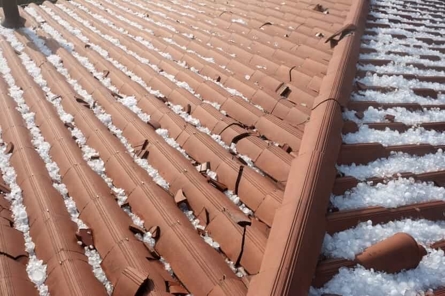Living in Cheyenne means dealing with frequent hailstorms, especially during our peak season from May to September. Understanding how to identify hail damage helps protect your home's integrity in Wyoming's severe weather conditions.
Our city's elevation of 6,062 feet and location along the Front Range makes us particularly vulnerable to destructive hailstorms, with hail sizes sometimes exceeding golf ball dimensions. Learning to spot damage early can prevent costly repairs later.
How Does Hail Damage Affect Different Roofing Materials?
Cheyenne homes feature various roofing materials, each showing distinct patterns of hail damage. The intensity of our storms, combined with high-altitude UV exposure, can create unique damage patterns that homeowners need to understand.
Signs of Hail Damage on Asphalt Shingles
Asphalt shingles, the most common roofing material in Cheyenne, show specific indicators of hail impact. Fresh hail damage appears as dark spots where granules have been knocked away, leaving the underlying mat exposed to our intense Wyoming sun.
Look for these telltale signs:
Random damage patterns with no straight lines
Dark circular spots with a shiny center
Exposed asphalt where granules are missing
Soft spots that feel like bruises when pressed
These indicators become more visible after several days of sun exposure, as our high-altitude climate accelerates the aging of damaged areas. Regular inspection after storms helps catch this damage early.
How Metal Roofs Show Hail Impact
Metal roofing, increasingly popular in Cheyenne for its durability against our extreme weather, displays hail damage differently than traditional materials. Our severe storms can leave distinctive marks that compromise your roof's protective finish.
Inspect metal roofing carefully for these distinctive markers:
Dents and dings of varying sizes
Scratched or chipped protective coating
Loosened or damaged seams
Impact marks near ridge caps
Beyond these immediate signs, pay attention to any new leaks or drafts. Cheyenne's frequent wind-driven storms can compound hail damage, particularly on metal panels weakened by impact.
Identifying Damage on Tile and Slate Roofs
Though less common in Cheyenne, tile and slate roofs require special attention after hailstorms. These materials, while durable, can crack or break under the impact of Wyoming's larger hailstones, especially during our severe summer storms.
Common damage patterns include:
Given our city's extreme temperature fluctuations, even minor cracks can quickly worsen as water seeps in and freezes. Regular professional inspections help prevent these issues from escalating.
Where Should You Look for Hail Damage First?
After a hailstorm passes through Cheyenne, certain areas of your roof deserve immediate attention. Our city's notorious winds often concentrate damage on specific sections of the roof.
Check These High-Impact Areas
Start your inspection with the areas most vulnerable to our local storm patterns. Cheyenne's prevailing northwest winds typically cause more severe damage on west and north-facing slopes.
Focus your initial inspection on:
Ridge caps and roof peaks
Northern and western slopes
Valleys and flashings
Areas around vents and chimneys
Gutter systems and downspouts
Remember that damage might not be immediately visible from ground level. Our intense Wyoming sun can make spotting subtle damage challenging without a closer look.
How Can You Safely Inspect Your Roof?
In Cheyenne's unpredictable weather, safety during roof inspection is paramount. Our high altitude and frequent wind gusts make roof access particularly dangerous, especially after storms.
Ground-Level Inspection Techniques
Begin your assessment safely from the ground using binoculars or a high-resolution camera. Cheyenne's clear mountain air provides good visibility for spotting obvious damage, though you'll want to inspect during morning or evening hours when glare is minimal.
Start by documenting:
Missing or displaced shingles
Obvious dark spots or bare patches
Damaged gutters and downspouts
Debris from recent storms
After your initial ground assessment, create a detailed record of potential damage areas. This documentation proves valuable when working with insurance adjusters and roofing professionals.
When to Call a Professional Inspector
While ground-level inspection provides valuable information, Cheyenne's severe weather patterns often necessitate professional assessment. Our region's unique challenges, from intense UV exposure to extreme temperature swings, require experienced evaluation.
Professional inspectors know how to identify:
Hidden structural damage
Early signs of water infiltration
Damage to underlying roofing layers
Installation issues that may worsen damage
Problems specific to high-altitude conditions
Consider professional inspection especially after storms producing hail larger than a quarter, common in our summer weather patterns.
What Steps Should You Take After Finding Damage?
Once you've identified hail damage, taking prompt action helps prevent further deterioration. Cheyenne's weather can quickly compound initial damage, particularly during our volatile spring and summer seasons.
Document Everything Thoroughly
Start by creating comprehensive documentation of all damage. Wyoming insurance companies typically require detailed evidence for hail damage claims.
Begin your documentation by:
Taking dated photographs of all damage
Recording the storm date and time
Measuring hailstone sizes if possible
Noting any immediate leaks or issues
Saving local weather reports
Creating a detailed damage map of your roof
Professional documentation strengthens your insurance claim and helps ensure proper repairs.
Need Professional Hail Damage Assessment?
Don't let hail damage compromise your roof's integrity. ServiceMaster by Country Lane understands Cheyenne's unique roofing challenges and provides thorough damage assessment and restoration services.
Contact ServiceMaster by Country Lane today for expert hail damage inspection and reliable restoration solutions.


